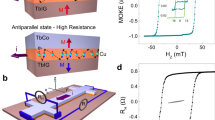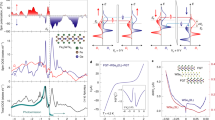Abstract
Electrical manipulation and detection of antiferromagnetic order could be used to create reliable and fast spintronic memory devices. The state of antiferromagnets can be read out using signals such as the anisotropic magnetoresistance and anomalous Hall effect, but these signals remain low, which restricts device development. Here we report the electrical detection of antiferromagnetism in Pt/IrMn/CoFeB/MgO/CoFeB three-terminal magnetic tunnel junctions using tunnelling magnetoresistance. We measure a tunnelling magnetoresistance ratio of over 80%, which is achieved by imprinting the antiferromagnetic state of IrMn on the ferromagnetic CoFeB free layer. We show current-polarity-dependent switching of IrMn down to 0.8 ns and identify two switching mechanisms: a heat-driven mode and a spin–orbit-torque-driven mode. The dominant switching mechanism depends on the current pulse width. Numerical simulations suggest that the spin–orbit torque generated by Pt induces the precession of IrMn moments and that exchange coupling at the IrMn/CoFeB interface determines the switching polarity of IrMn.
This is a preview of subscription content, access via your institution
Access options
Access Nature and 54 other Nature Portfolio journals
Get Nature+, our best-value online-access subscription
$29.99 / 30 days
cancel any time
Subscribe to this journal
Receive 12 digital issues and online access to articles
$119.00 per year
only $9.92 per issue
Buy this article
- Purchase on Springer Link
- Instant access to full article PDF
Prices may be subject to local taxes which are calculated during checkout




Similar content being viewed by others
Data availability
The data that support the plots within this paper and the other findings of this study are available from the corresponding author upon reasonable request.
Code availability
The codes used in this paper are available from the corresponding author upon reasonable request.
References
Dieny, B. et al. Opportunities and challenges for spintronics in the microelectronics industry. Nat. Electron. 3, 446–459 (2020).
Guo, Z. et al. Spintronics for energy-efficient computing: an overview and outlook. Proc. IEEE 109, 1398–1417 (2021).
Miron, I. M. et al. Perpendicular switching of a single ferromagnetic layer induced by in-plane current injection. Nature 476, 189–193 (2011).
Liu, L. et al. Spin-torque switching with the giant spin Hall effect of tantalum. Science 336, 555–558 (2012).
Ikeda, S. et al. A perpendicular-anisotropy CoFeB–MgO magnetic tunnel junction. Nat. Mater. 9, 721–724 (2010).
Wang, M. et al. Field-free switching of a perpendicular magnetic tunnel junction through the interplay of spin–orbit and spin-transfer torques. Nat. Electron. 1, 582–588 (2018).
Grimaldi, E. et al. Single-shot dynamics of spin–orbit torque and spin transfer torque switching in three-terminal magnetic tunnel junctions. Nat. Nanotechnol. 15, 111–117 (2020).
Parkin, S. S. P. et al. Giant tunnelling magnetoresistance at room temperature with MgO (100) tunnel barriers. Nat. Mater. 3, 862–867 (2004).
Yuasa, S., Nagahama, T., Fukushima, A., Suzuki, Y. & Ando, Y. Giant room-temperature magnetoresistance in single-crystal Fe/MgO/Fe magnetic tunnel junctions. Nat. Mater. 3, 868–871 (2004).
Ikeda, S. et al. Tunnel magnetoresistance of 604% at 300 K by suppression of Ta diffusion in CoFeB/MgO/CoFeB/ pseudo-spin-valves annealed at high temperature. Appl. Phys. Lett. 93, 082508 (2008).
Baltz, V. et al. Antiferromagnetic spintronics. Rev. Mod. Phys. 90, 015005 (2018).
Jungwirth, T., Marti, X., Wadley, P. & Wunderlich, J. Antiferromagnetic spintronics. Nat. Nanotechnol. 11, 231–241 (2016).
Jungfeisch, M. B., Zhang, W. & Hofmann, A. Perspectives of antiferromagnetic spintronics. Phys. Lett. A 382, 865–871 (2018).
Železný, J. et al. Spin transport and spin torque in antiferromagnetic devices. Nat. Phys. 14, 220–228 (2018).
Wadley, P. et al. Electrical switching of an antiferromagnet. Science 351, 587–590 (2016).
Chen, X. et al. Electric field control of Néel spin–orbit torque in an antiferromagnet. Nat. Mater. 18, 931–935 (2019).
Manchon, A. et al. Current-induced spin-orbit torques in ferromagnetic and antiferromagnetic systems. Rev. Mod. Phys. 91, 035004 (2019).
Shi, J. et al. Electrical manipulation of the magnetic order in antiferromagnetic PtMn pillars. Nat. Electron. 3, 92–98 (2020).
DuttaGupta, S. et al. Spin-orbit torque switching of an antiferromagnetic metallic heterostructure. Nat. Commun. 11, 5715 (2020).
Baldrati, L. et al. Mechanism of Néel order switching in antiferromagnetic thin films revealed by magnetotransport and direct imaging. Phys. Rev. Lett. 123, 177201 (2019).
Moriyama, T., Oda, K., Ohkochi, T., Kimata, M. & Ono, T. Spin torque control of antiferromagnetic moments in NiO. Sci. Rep. 8, 14167 (2018).
Arpaci, S. et al. Observation of current-induced switching in noncollinear antiferromagnetic IrMn3 by differential voltage measurements. Nat. Commun. 12, 3828 (2021).
Tsai, H. et al. Electrical manipulation of a topological antiferromagnetic state. Nature 580, 608–613 (2020).
Higo, T. et al. Perpendicular full switching of chiral antiferromagnetic order by current. Nature 607, 474–479 (2022).
Park, B. G. et al. A spin-valve-like magnetoresistance of an antiferromagnet-based tunnel junction. Nat. Mater. 10, 347–351 (2011).
Chiang, C. C., Huang, S. Y., Qu, D., Wu, P. H. & Chien, C. L. Absence of evidence of electrical switching of the antiferromagnetic Néel vector. Phys. Rev. Lett. 123, 227203 (2019).
Godinho, J. et al. Electrically induced and detected Néel vector reversal in a collinear antiferromagnet. Nat. Commun. 9, 4686 (2018).
Jenkins, S., Chantrell, Roy, W. & Evans, R. F. L. Atomistic origin of the athermal training effect in granular IrMn/CoFe bilayers. Phys. Rev. B 103, 104419 (2021).
Ohldag, H. et al. Correlation between exchange bias and pinned interfacial spins. Phys. Rev. Lett. 91, 017203 (2003).
Prejbeanu, I. L. et al. Thermally assisted MRAM. J. Phys.: Condens. Matter 19, 165218 (2007).
Prejbeanu, I. L. et al. Thermally assisted MRAMs: ultimate scalability and logic functionalities. J. Phys. D: Appl. Phys. 46, 074002 (2013).
Reichlová, H. et al. Current-induced torques in structures with ultrathin IrMn antiferromagnets. Phys. Rev. B 92, 165424 (2015).
Kim, H. J., Je, S. G., Jung, D. H., Lee, K. S. & Hong, J. I. Field-free control of exchange bias by spin Hall currents. Appl. Phys. Lett. 115, 022401 (2019).
Sala, G. et al. Real-time Hall-effect detection of current-induced magnetization dynamics in ferrimagnets. Nat. Commun. 12, 656 (2021).
Wang, X. et al. Spin-orbit-coupled transport and spin torque in a ferromagnetic heterostructure. Phys. Rev. B 89, 054405 (2014).
Liu, L., Moriyama, T., Ralph, D. C. & Buhrman, R. A. Spin-torque ferromagnetic resonance induced by the spin Hall effect. Phys. Rev. Lett. 106, 036601 (2011).
Peng, S. et al. Exchange bias switching in an antiferromagnet/ferromagnet bilayer driven by spin–orbit torque. Nat. Electron. 3, 757–764 (2020).
Lin, P. H. et al. Manipulating exchange bias by spin–orbit torque. Nat. Mater. 18, 335–341 (2019).
Fang, B. et al. Electrical manipulation of exchange bias in an antiferromagnet/ferromagnet-based device via spin–orbit torque. Adv. Funct. Mater. 32, 2112406 (2022).
Zhang, W. et al. Spin Hall effects in metallic antiferromagnets. Phys. Rev. Lett. 113, 196602 (2014).
Wang, X. et al. Spin transmission in IrMn through measurements of spin Hall magnetoresistance and spin-orbit torque. Phys. Rev. B 101, 144412 (2020).
Cheng, R., Daniels, M. W., Zhu, J.-G. & Xiao, D. Ultrafast switching of antiferromagnets via spin-transfer torque. Phys. Rev. B 91, 064423 (2015).
Evans, R. F. L. et al. Atomistic spin model simulations of magnetic nanomaterials. J. Phys.: Condens. Matter 26, 103202 (2014).
Jenkins, S. et al. Atomistic origin of exchange anisotropy in noncollinear γ-IrMn3–CoFe bilayers. Phys. Rev. B 102, 140404(R) (2020).
Aradhya, S. V., Rowlands, G. E., Oh, J., Ralph, D. C. & Buhrman, R. A. Nanosecond-timescale low energy switching of in-plane magnetic tunnel junctions through dynamic Oersted-field-assisted spin Hall effect. Nano Lett. 16, 5987–5992 (2016).
Honjo, H. et al. First demonstration of field-free SOT-MRAM with 0.35 ns write speed and 70 thermal stability under 400 °C thermal tolerance by canted SOT structure and its advanced patterning/SOT channel technology. In 2019 IEEE International Electron Devices Meeting (IEDM) 28.5.1–28.5.4 (IEEE, 2019).
Dong, J. et al. Tunneling magnetoresistance in noncollinear antiferromagnetic tunnel junctions. Phys. Rev. Lett. 128, 197201 (2022).
Shao, D. et al. Spin-neutral currents for spintronics. Nat. Commun. 12, 7061 (2021).
Meer, H. et al. Direct imaging of current-induced antiferromagnetic switching revealing a pure thermomagnetoelastic switching mechanism in NiO. Nano Lett. 21, 114–119 (2021).
Acknowledgements
This work was supported by the National Key Research and Development Program of China (2022YFB4400200, W.Z.; 2022YFA1402604, D.Z.), National Natural Science Foundation of China (92164206, W.Z.; 62271026, K.S.; 62001014, K.C.; 52121001, W.Z.), National Postdoctoral Program for Innovative Talents (BX20220374, D.Z.) and Outstanding Research Project of Shenyuan Honors College (BUAA 230121102, A.D.) and the Tencent Foundation through the XPLORER PRIZE (W.Z.). We thank Y. Han (Center of Nanofabrication, Tsinghua University) for technical assistance.
Author information
Authors and Affiliations
Contributions
W.Z. initialized, conceived and supervised the project. Z.G. and S. Lu designed and optimized the MTJ stack. A.D., Z.G., R.X., J.Y. and C.Z. fabricated the devices under the guidance of K.C. and K.S. A.D., D.Z., Z.G., D.X. and W.C. performed the measurements. D.Z. and Z.Z. performed the numerical simulations, and S. Luo and A.F. analysed the results. A.D., D.Z., K.C., Z.Z., Z.G. and W.Z. wrote the manuscript. All authors discussed the results and commented on the manuscript.
Corresponding author
Ethics declarations
Competing interests
The authors declare no competing interests.
Peer review
Peer review information
Nature Electronics thanks the anonymous reviewers for their contribution to the peer review of this work.
Additional information
Publisher’s note Springer Nature remains neutral with regard to jurisdictional claims in published maps and institutional affiliations.
Supplementary information
Supplementary Information
Supplementary Sections 1–25.
Rights and permissions
Springer Nature or its licensor (e.g. a society or other partner) holds exclusive rights to this article under a publishing agreement with the author(s) or other rightsholder(s); author self-archiving of the accepted manuscript version of this article is solely governed by the terms of such publishing agreement and applicable law.
About this article
Cite this article
Du, A., Zhu, D., Cao, K. et al. Electrical manipulation and detection of antiferromagnetism in magnetic tunnel junctions. Nat Electron 6, 425–433 (2023). https://doi.org/10.1038/s41928-023-00975-3
Received:
Accepted:
Published:
Issue Date:
DOI: https://doi.org/10.1038/s41928-023-00975-3
This article is cited by
-
Orbitronics: light-induced orbital currents in Ni studied by terahertz emission experiments
Nature Communications (2024)
-
Current-controlled antiferromagnetic memory
Nature Electronics (2023)



